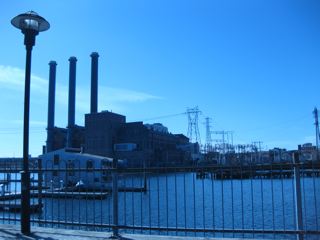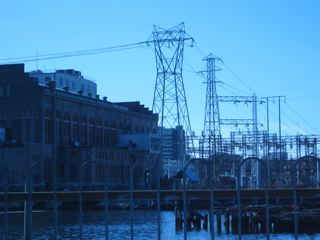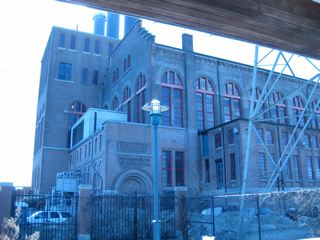THE MANCHESTER STREET GENERATING STATION
From across the Providence River, the active Manchester Street Generating Station is striking. With its three glowing, 321-foot smoke stacks, the station still carries the sheen of its 1996 renovation. As the oldest electrical generating station in Providence, it has been in operation since 1903, but it doesn’t much look it. Nearby, crouched lower to the ground, the patchily faded red brick of the defunct South Street Station shows its age. South Street was constructed by Narragansett Electric Lighting Co. between 1912 and 1925, and after enduring periodic additions and renovations throughout the 1900s, it finally shut down for good in 1991. The city gets its power from Manchester Street now; South Street is empty. The two stand on the banks of the river, Manchester backed by a bristling jungle of transformers and wires, the stations distinct and yet essentially conjoined.

The Manchester Street Generating Station

In the roughly one hundred years since their construction, the two stations have come to act as an architectural palimpsest for the city of Providence. They were expanded, rebuilt, added to as the city’s electrical needs changed, and their piecemeal development mirrors that of Providence itself. As environmental concerns grew more prominent, the stations adapted; Manchester Street’s 1996 renovation re-powered the station with natural gas turbines – rather than oil – as its primary source of energy. If, as we suggested in one of our first classes, an action, a word, never really leaves the space in which it first came into being, then a century’s worth of local memory is embedded in the air around Manchester Street and South Street.
I focused my exploration and research of the sites on the Manchester Street Station, but the histories of the two and their associated memories are intertwined in such a way that no examination of Manchester Street would be complete without some mention of South Street. My photographs primarily feature Manchester Street, but because South Street sheds light on many of the complexities that arise in connection with Manchester Street, I’ve chosen to discuss both stations in some of following sections.
When I made the trip to get as close to the Manchester Street station as I could, I expected that there would be a low hum, menacing, reverberating out of the ground underneath the chain-link fences that separates the building from the small, concrete park that runs along the river. The sound is barely perceptible. The hum of the ventilation systems at Brown University’s Rockefeller Library makes more noise. The station is surprisingly colorful: pinkish bricks, red-rimmed windows, even the deep blue hue of the leviathan stacks, which I would have said were pure black. An orange electrical glow appears in spots behind the frosted windows. Behind the locked gate at the end of the park is a pile of snow so filthy that it looks like rocks. The loudest sound comes from the gray-green water that pours steadily out of the banks, back into the river. There are cars in the parking lot – people are at work – and yet the air feels unbreathed.

As I searched for information about this building and its history, three general themes began to emerge to me, and in the in the following sections, I explore the ways in which Manchester Street – and, frequently, South Street as well – embody some of the central complexities in the intermingling of architecture and memory. Unsurprisingly, I found myself encountering many more questions than answers, but the pair of stations makes for an intriguing case study of how architecture interacts with the society in which it exists.
Dark and Light, Form and Function
The Human Experience of the Industrial: Interaction, Distance, and Imagination
